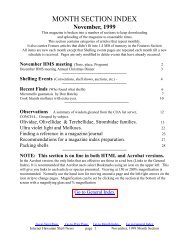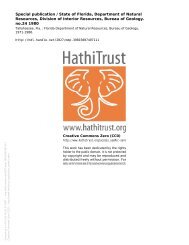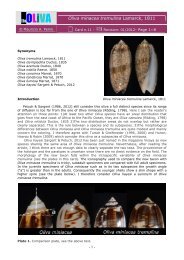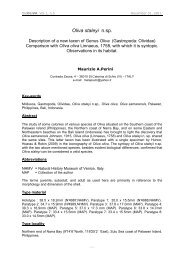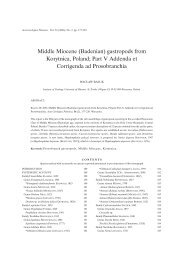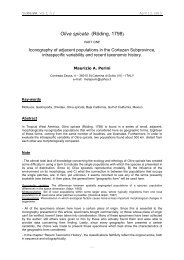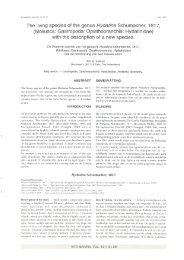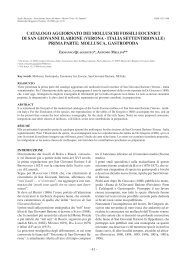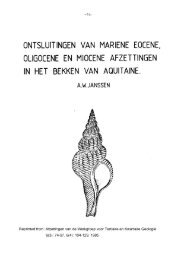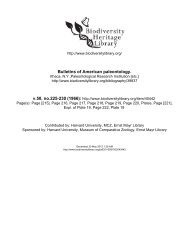Miocene molluscs from Muara Kobun and Pulu ... - Naturalis
Miocene molluscs from Muara Kobun and Pulu ... - Naturalis
Miocene molluscs from Muara Kobun and Pulu ... - Naturalis
You also want an ePaper? Increase the reach of your titles
YUMPU automatically turns print PDFs into web optimized ePapers that Google loves.
Beets, <strong>Miocene</strong> <strong>molluscs</strong> <strong>from</strong> <strong>Muara</strong> <strong>Kobun</strong> & <strong>Pulu</strong> Senumpah, Scripta Geol. 67 (1983)<br />
<strong>Miocene</strong> <strong>molluscs</strong> <strong>from</strong> <strong>Muara</strong> <strong>Kobun</strong><br />
<strong>and</strong> <strong>Pulu</strong> Senumpah, Sangkulirang Bay,<br />
northern Kutai (East Borneo)<br />
C. Beets<br />
Beets, C. <strong>Miocene</strong> <strong>molluscs</strong> <strong>from</strong> <strong>Muara</strong> <strong>Kobun</strong> <strong>and</strong> <strong>Pulu</strong> Senumpah, Sangkulirang<br />
Bay, northern Kutai (East Borneo). - Scripta Geol., 67: 1-21, 1 fig., pl;. 1, Leiden,<br />
October 1983.<br />
The fossils <strong>from</strong> <strong>Muara</strong> <strong>Kobun</strong> were collected by M. Schmidt (Royal Dutch Petroleum<br />
Company) as far back as 1902. Eighteen species, including two new ones<br />
(Cerithium (Gourmya) kobunense <strong>and</strong> Carditella witkampi) have been examined,<br />
the majority being gastropods whose combined stratigraphical ranges suggest a<br />
Preangerian age, with, however, the additional stipulation that perhaps some level<br />
high up in Tertiary f3 is involved rather than an age comparable to that of the<br />
Gelingseh faunas first partly described by K. Martin <strong>and</strong> the present writer.<br />
The <strong>molluscs</strong> <strong>from</strong> <strong>Pulu</strong> Senumpah were collected by L.M.R. Rutten in the<br />
period 1911-1913. There are no more than seven species, all gastropods, over half<br />
of which indicate best relationships with the <strong>Muara</strong> <strong>Kobun</strong> fauna, hence their<br />
being tentatively assigned the same age.<br />
C. Beets, Backershagenlaan 18, 2243 AC Wassenaar, The Netherl<strong>and</strong>s.<br />
Introduction 1<br />
Description of the molluscan species 2<br />
<strong>Muara</strong> <strong>Kobun</strong> 2<br />
<strong>Pulu</strong> Senumpah 10<br />
Faunal lists 12<br />
Age determinations 15<br />
<strong>Muara</strong> <strong>Kobun</strong> 15<br />
<strong>Pulu</strong> Senumpah 17<br />
References 18<br />
1
2<br />
Beets, <strong>Miocene</strong> <strong>molluscs</strong> <strong>from</strong> <strong>Muara</strong> <strong>Kobun</strong> & <strong>Pulu</strong> Senumpah, Scripta Geol. 67 (1983)<br />
Fig. 1. Sketch map of Sangkulirang Bay area.<br />
Sg. = Sungai (river), P. = <strong>Pulu</strong> (isl<strong>and</strong>).<br />
Introduction<br />
The present paper deals in the first place with a rather small, yet interesting fauna<br />
of Neogene Mollusca <strong>from</strong> <strong>Muara</strong> <strong>Kobun</strong> in the Sangkulirang Bay. The material<br />
was labelled: '<strong>Muara</strong> <strong>Kobun</strong>, Sangkulirang, Kutai-Ufer am Tongkang<br />
M. Schmidt leg., 29-6-1902'. Dr Schmidt collected the fossils while carrying out<br />
geological explorations on behalf of the Royal Dutch Petroleum Company, later<br />
Bataafsche Petroleum Maatschappij <strong>and</strong> now, Shell Internationale Petroleum<br />
Maatschappij (S.I.P.M.). He mentioned the locality in a company report dated<br />
30-7-1902 which S.I.P.M. kindly made available to the writer in recent months.<br />
The locality is situated on the west bank of <strong>Pulu</strong> Sinku(w)ang (Fig. 1), apparently<br />
at the time close to a barge (tongkang, for transshipment of loads to <strong>and</strong> <strong>from</strong><br />
ships <strong>and</strong> l<strong>and</strong>), which presumably by being anchored or made fast by hawsers<br />
acted as a jetty <strong>and</strong> thus, in those early exploration days, could serve as a welcome<br />
l<strong>and</strong>mark where there were few others present. The locality is also obliquely<br />
across the <strong>Muara</strong> (roadstead) <strong>Kobun</strong>, <strong>from</strong> the mouth of Sungai Taritip, or<br />
Teritip, on the nearby mainl<strong>and</strong>.<br />
Apart <strong>from</strong> <strong>molluscs</strong>, the locality (see: Gerth, 1923, pp. 41,46: loc. 39;<br />
compare p. 47, loc. 40) yielded but a single coral, a solitary one of deeper water<br />
habitat, which was described as Acanthocyathus malayicus Gerth, 1923 (I.e.,<br />
p. 57, pl. 1, figs. 20-21), subsequently also recorded <strong>from</strong> Pliocene/Pleistocene<br />
deposits of Ceram (see: Gerth, 1925, p. 53). Gerth somewhat casually concluded<br />
that its age could be Late <strong>Miocene</strong> but in 1925 he referred it to <strong>Miocene</strong>, unspe-
Beets, <strong>Miocene</strong> <strong>molluscs</strong> <strong>from</strong> <strong>Muara</strong> <strong>Kobun</strong> & <strong>Pulu</strong> Senumpah, Scripta Geol. 67 (1983) 3<br />
cified. The last reference to the locality was made by Krijnen (1931, p. 532,<br />
Nr 176), who classified it, together with a number of other localities, as 'Young<br />
<strong>Miocene</strong>, Gelingseh beds, Tertiary f (i.e., Tf3).<br />
In addition to the coral described by Gerth, <strong>and</strong> the <strong>molluscs</strong> discussed below,<br />
the following fossils <strong>from</strong> <strong>Muara</strong> <strong>Kobun</strong> appeared to be present in the collections<br />
of the Rijksmuseum van Geologie en Mineralogie: Flabellum spp. (two),<br />
Heterocyathus spp. (two), one of which is H. parasiticus Semper, 1872, <strong>and</strong><br />
other corals; finally, a few echinoid spines (Cidaris? sp.).<br />
In the second place, a few <strong>molluscs</strong> are described <strong>from</strong> L.M.R. Rutten's loc.<br />
156, <strong>Pulu</strong> Senumpah, likewise in the Sangkulirang Bay (Fig. 1). Most of the species<br />
have been mentioned before (Beets, 1941, pp. 194-196). According to<br />
Rutten the stratigraphie level of this small assemblage could be somewhat higher<br />
than that of the fauna of the Gelingseh Beds first discussed by Martin (1914)<br />
<strong>and</strong> the present writer (1941).<br />
Description of the molluscan species<br />
MUARA KOBUN<br />
The material is kept in the Rijksmuseum van Geologie en Mineralogie, the registration<br />
numbers being preceded by the abbreviation RGM. For stratigraphical<br />
data see the next chapter.<br />
Rhinoclavis (Rhinoclavis) junghuhni (Wanner & Hahn, 1935)<br />
Material-RGM 312 026.<br />
Range - Pre-Preangerian to Preangerian: R - NT (Gelingseh Beds: source area of<br />
Sungai Gelingseh; Sekurau).<br />
Comment - This species is represented by two specimens which agree very well<br />
with material <strong>from</strong> both the <strong>Miocene</strong> of Sekurau <strong>and</strong> Sungai Gelingseh.<br />
References - Wanner & Hahn, 1935, pp. 238,259, pi. 19, fig. 26 (Potamides<br />
(Terebralia) Junghuhni Wanner & Hahn); Pannekoek, 1936, p. 7.<br />
Cerithium (Gourmya) kobunense spec. nov.<br />
PI. l,figs. 1-6<br />
Holotype - RGM 312 151;PI. l,figs. 1-3. Length: 21 mm.<br />
Paratypes — RGM 312 152; PI. 1, figs. 4-6. Length 25.6 mm RGM 312 153 (2 specimens).<br />
Type-locality - <strong>Muara</strong> <strong>Kobun</strong>, <strong>Pulu</strong> Sinkuang, Sangkulirang Bay, E. Borneo.<br />
Type-horizon - Not specified, presumably some level high up in the Gelingseh Beds.<br />
Name - Derived <strong>from</strong> the type-locality.
4 Beets, <strong>Miocene</strong> <strong>molluscs</strong> <strong>from</strong> <strong>Muara</strong> <strong>Kobun</strong> & <strong>Pulu</strong> Senumpah, Scripta Geol. 67 (1983)<br />
Range — No previous records.<br />
Description — The rare subgenus Gourmya Bayle (in Fischer), 1884, is here represented<br />
by a characteristic species. Four specimens are available, two of which<br />
are rather poorly preserved. The figured paratype, the largest specimen on h<strong>and</strong>,<br />
is comparatively plump, while the holotype is slenderer. The protoconch is not<br />
preserved. The spire whorls are flat, but clearly defined, although the sutures are<br />
not very distinct.<br />
The sculpture is quite simple: as in certain other species of Gourmya, it<br />
consists of a number of primary <strong>and</strong> secondary spiral lirae, one secondary spiral<br />
between each couple of primary ones. On the youngest whorls, a more prominent<br />
spiral may be visible in the abapical suture.<br />
The last whorl is large <strong>and</strong> entirely covered with spirals of two sizes. On<br />
this, <strong>and</strong> preceding whorls, the growth lines are rather inconspicuous, slightly<br />
arched forward at the adapical suture, slightly arched backward over the greatest<br />
part of the whorls <strong>and</strong> somewhat forward again over the base of the shell, while<br />
finally they turn towards the columella in a short curve.<br />
The outer lip is provided with a rather strong varix but its edge is thin <strong>and</strong><br />
sharp. No other varices are developed. The inside of the outer lip is smooth, <strong>and</strong><br />
so is the columellar lip, while the parietal lip bears a conspicuous parietal ridge.<br />
The columellar lip is thin, except anteriorly where it detaches itself a little <strong>from</strong><br />
the base.<br />
No closely related species are known to the writer, except perhaps the<br />
living C. gourmyi Crosse, 1861, <strong>from</strong> New Caledonia which however is more<br />
than double the size of the new species <strong>and</strong> gross of appearance.<br />
Niso (Niso) spec. indet.<br />
Material - RGM 312 030. Length 7+ mm.<br />
Range — No previous records.<br />
Comment — The specimen's apical portion is damaged.<br />
The worls of the teleoconch are slightly convex, low <strong>and</strong> separated by rather<br />
conspicuous sutures. They are glossy in appearance <strong>and</strong> bear some exceedingly<br />
fine growth lines, a few of which may be more conspicuous.<br />
The last whorl is rather high, with a conspicuously rounded periphery <strong>and</strong> a<br />
convex base. The umbilicus is fairly narrow, smooth <strong>and</strong> encircled by a rounded,<br />
rather narrow convexity. The outer lip almost orthocline, sometimes, as indicated<br />
by growth lines, arching slightly forward at the adapical suture <strong>and</strong> also on<br />
the base next to the periphery, arching slightly backward on the rest of the base.<br />
The inner lip thin, its abapical portion slightly thicker <strong>and</strong> somewhat exp<strong>and</strong>ed<br />
over the umbilicus.<br />
The specimen is reminiscent of N. brunnea (Sowerby, 1834) (Nomura,<br />
1935, p. 221, pi. 10, fig. 28), which has, however, an angular periphery. N.<br />
niasensis Wissema, 1947 (Wissema, 1947, p. 78, pi. 3, figs. 92-93) is bigger <strong>and</strong><br />
has flat whorls, its umbilicus being encircled by a sharp keel <strong>and</strong> the umbilical<br />
wall bearing a crenulated keel.
Beets, <strong>Miocene</strong> <strong>molluscs</strong> <strong>from</strong> <strong>Muara</strong> <strong>Kobun</strong> & <strong>Pulu</strong> Senumpah, Scripta Geol. 67 (1983)<br />
Capulus spec, indet.<br />
Material RGM 312 041.<br />
Range - No previous records.<br />
Comment — A single specimen is available which is reminiscent of C. javanus<br />
Wanner & Hahn, 1935 (Wanner & Hahn, 1935, p. 263, pi. 20, figs. 57, pi. 21,<br />
fig. 1 ) <strong>from</strong> the Rembang Beds, but it is too much damaged to be described.<br />
Tibia (Sulcogladius) powisii (Petit, 1840)<br />
Material- RGM 312 033.<br />
Range - Preangerian to Recent: NT (loc. 156, <strong>Pulu</strong> Senumpah, Rutten)<br />
M ('upper <strong>Miocene</strong>': Timor; New Guinea) Ρ Re.<br />
Comments - The body whorl of a single damaged specimen is available. It belongs<br />
to the var. modesta (Martin, 1899) <strong>and</strong> agrees particularly well with specimens<br />
<strong>from</strong> the Kendeng Beds identified by van Regieren Altena (Altena, 1941,<br />
p. 45, with syn.). The spiral depression of the abapical side of the shoulder is<br />
somewhat less concave than in the Sondé shells.<br />
Tibia (Rostellariella) butaciana (Martin, 1899)<br />
MaterialRGM 312 034.<br />
Range — PrePreangerian: R Rr (Rm).<br />
Comments — This characteristic species is represented by five specimens; four<br />
spires <strong>and</strong> an almost fullgrown shell. The material agrees very well with the Javanese<br />
type specimens <strong>and</strong> with undescribed material <strong>from</strong> the Rembang Beds of<br />
Madura which is now under examination.<br />
References Martin, 18911922, p. 190, pi. 30, figs. 441442 (Rostellaria<br />
(s. str.) butaciana Martin); van der Vlerk, 1931, p. 246; Wanner & Hahn, 1935,<br />
pp. 235, 236, 258.<br />
Polinices (Polinices) cumingianus (Récluz, 1844)<br />
Material — RGM 312 038.<br />
Range - PrePreangerian to Recent: RRr (Ra, R1)UG (Pakistan) Nj Tj<br />
(loc. O, Junghuhn) Ta Pa NT (Loc. R, Tjikarang, Junghuhn; West Borneo) <br />
M Ρ Ν (e.g., Tji Gugur) PQ Q RE.<br />
5
6<br />
Beets, <strong>Miocene</strong> <strong>molluscs</strong> <strong>from</strong> <strong>Muara</strong> <strong>Kobun</strong> & <strong>Pulu</strong> Senumpah, Scripta Geol. 67 (1983)<br />
Comments — This characteristic species is represented by four specimens, two<br />
being immature. The largest specimen agrees particularly well with van Regteren<br />
Altena's fig. 16.<br />
References - Altena, 1941, p. 58, with syn.; Altena & Beets, 1945, pp. 38, 60;<br />
Wissema, 1947, p. 126.<br />
Naticarius (Naticarius) lineatus (Roeding, 1798)<br />
Material - RGM 312 040.<br />
Range — Pre-Preangerian to Recent: R - Rr (Rm, Rl) - NT (Lower Palembang<br />
Beds) - Ρ - PQ - Q - Re.<br />
Comment — A single immature specimen is available which matches other Recent<br />
<strong>and</strong> fossil shells of the same size.<br />
References — Altena, 1941, p. 79, with syn.; Wissema, 1947, p. 135; Beets,<br />
1950c, p. 331.<br />
Ficus (Ficus) spec. nov.<br />
Material - RGM 312 042.<br />
Range - Pre-Preangerian to Preangerian: Rr (Ra?, Rm?, Rl (Holotype)) -NT<br />
(Lower Palembang Beds?).<br />
Comment — Three damaged specimens are available, which agree so well with<br />
the type material of an as yet undescribed species <strong>from</strong> Rembang deposits of<br />
Sumatra that their identity with the latter can hardly be doubted.<br />
Oliva spec. indet.<br />
Material — RGM 312 050.<br />
Range — No previous records.<br />
Comment — Three damaged specimens are available which could not be identified.<br />
Marginella (Cryptospira) aff. M.(C) elegans (Gmelin, 1788)<br />
Material — RGM 312 056.<br />
Range — Pre-Preangerian to Preangerian: R - Rr (Rm, Rl) - Tj (incl. loc. O,<br />
Junghuhn)-NT (Gelingseh Beds: Sg. Gelingseh, 'layer 1', loc. 144, Rutten,
Beets, <strong>Miocene</strong> <strong>molluscs</strong> <strong>from</strong> <strong>Muara</strong> <strong>Kobun</strong> & <strong>Pulu</strong> Senumpah, Scripta Geol. 67 (1983)<br />
loc. 150, Rutten; Kari Orang; Sekurau; Gunung Madupar, Wanner; Lower<br />
Palembang Beds).<br />
Comments — Two well preserved specimens are available.<br />
Reference - Beets, 1950c, p. 335.<br />
Clavus spec. indet. b<br />
Material - RGM 312 058.<br />
Range — No previous records.<br />
Comment — A single badly damaged specimen available.<br />
Gemmula (Gemmula) granosa woodwardi (Martin, 1884)<br />
Material-RGM 312 063.<br />
Range - Pre-Preangerian to Pliocene, Neogene: R-Rr (Ra; Rm; R1)-K-UG<br />
(Assam)-NT (M<strong>and</strong>ul; loc. 156, <strong>Pulu</strong> Senumpah, Rutten; Gelingseh Beds:<br />
loc. 144, Rutten; Menta wir Beds s. str.; West Borneo; Tjikao; Lower Palembang<br />
Beds) - UM (Dingle Formation, Panay) - Ρ - Ν.<br />
Comment — Five specimens are available.<br />
References - Oostingh, 1935, pp. 110 (Tunis carinata woodwardi (Martin), with<br />
syn.), 210, 217, 226; Oostingh, 1938, p. 27; Beets, 1950c, p. 335; Beets, 1981a,<br />
pp. 4, 6.<br />
Lophiotoma indica (Roeding, 1798)<br />
Material — RGM 312 062.<br />
Range - Preangerian to Recent: Tj - NT (M<strong>and</strong>ul; loc. 141, Kari Orang, Rutten)<br />
- UM (Tjiodeng) - Ρ - Ν - PQ (Togopi) - Q - Re.<br />
Comments - Two damaged specimens available. The species will be discused in<br />
a paper on <strong>molluscs</strong> <strong>from</strong> M<strong>and</strong>ul.<br />
Conus fennemai Schepman, 1907<br />
Material - RGM 312 065.<br />
Range — Quaternary exclusively : Q.<br />
7
8<br />
Beets, <strong>Miocene</strong> <strong>molluscs</strong> <strong>from</strong> <strong>Muara</strong> <strong>Kobun</strong> & <strong>Pulu</strong> Senumpah, Scripta Geol. 67 (1983)<br />
Comments — The species was described <strong>from</strong> Kaju Ragi, N. Celebes. It is represented<br />
in the <strong>Muara</strong> <strong>Kobun</strong> collection by two specimens, 14.3 <strong>and</strong> 15 mm long<br />
respectively, smaller therefore than the type which is 25 mm long, but perfectly<br />
similar in other respects. The protoconch is partly preserved in one case, showing<br />
at least three smooth apical whorls.<br />
C. niasensis Woodward, 1879, the type of which is 15 mm long, is closely<br />
related (Woodward, 1879, p. 226, pi. 4, fig. 1), although its sculpture <strong>and</strong> shape<br />
seem to differ. Future finds may clarify the relationships between these species.<br />
Conus ornatissimus Martin, 1883<br />
Material — RGM 312 068.<br />
Range — Preangerian to Pliocene/Quaternary: Ta - Pa - NT (Loc. 156, <strong>Pulu</strong> Senumpah,<br />
Rutten) - UM (Dingle Formation, Panay) - M (New Guinea) - Ρ - PQ<br />
(Togopi?.; Ceram).<br />
Comments — A fragmentary specimen is available. It is so characteristic that the<br />
identification is considered safe. Cox (1948, p. 59, pi. 6, figs. 3a-d) described a<br />
new species, C. vlerki, which may not be C. ornatissimus as concluded by Shuto.<br />
Reference — Shuto, 1969, p. 221, with syn. (Asprella ornatissima (Martin)),<br />
pi. 22, figs. 1, 2, 4, 11-14; text-figs. 40-41.<br />
Conus cf. C. sinensis Sowerby, 1833<br />
Material-RGM 3\2 066.<br />
Range — Not fully ascertained, generally Preangerian to Recent: NT (loc. 141,<br />
Kari Orang, Rutten) - Re.<br />
Comments — There are two specimens available, one damaged at its anterior end,<br />
the other merely a spire. The shoulder-angle of the older whorls is not tubercled,<br />
but apart <strong>from</strong> that the material agrees well with specimens <strong>from</strong> Rutten's loc.<br />
141. C. sinensis not being clearly defined <strong>and</strong> its relationships to other species<br />
requiring revision, the writer uses it in a restricted fashion for age identification.<br />
Conus socialis Martin, 1895<br />
Material - RGM 312 067.<br />
Comments — A fine specimen <strong>and</strong> two spire fragments available. The material is<br />
particularly similar to Tesch's figs. 16a-b, quoted by Oostingh.<br />
Range — Preangerian to Pliocene, Neogene: Ta-NT (Lower Palembang Beds?;<br />
West Borneo) - Ρ - Ν (e.g., Tji Gugur).
Beets, <strong>Miocene</strong> <strong>molluscs</strong> <strong>from</strong> <strong>Muara</strong> <strong>Kobun</strong> & <strong>Pulu</strong> Senumpah, Scripta Geol. 67 (1983) 9<br />
References - Martin, 1928, pp. 13, 26; Haanstra & Spiker, 1932b, p. 1313; Oostingh,<br />
1938, p. 20; Altena & Beets, 1945, pp. 47, 60, pl., fig. 1 (var.); Beets,<br />
1950c, p. 336.<br />
Terebra (Myurella) cf. T. (M.) torquata pliocenica Koperberg, 1931<br />
Material — RGM 312 072.<br />
Range - Pliocene, Neogene: Ρ - Ν.<br />
Comment — A small specimen which could not be identified more securely.<br />
References - Koperberg, 1931, p. 38; de Bruijne, 1941, p. 27.<br />
Dentalium (Fissidentalium) magnificum junghuhni Martin, 1879<br />
Material-RGM 312 143.<br />
Range — Preangerian to Pliocene, Neogene: NT (loc. R, Tjikarang, Junghuhn) -<br />
Ρ-Ν.<br />
Comments — A single specimen is present. It agrees with numerous specimens in<br />
unpublished Pliocene collections <strong>from</strong> East Borneo. Tesch <strong>and</strong> Koperberg rightly<br />
drew attention to the close relationships between D. junghuhni <strong>and</strong> the living D.<br />
magnificum Smith, 1896, the writer being firmly convinced now that the former<br />
is but an ancestral form of the latter. The material recorded as D. junghuhni<br />
<strong>from</strong> Singu <strong>and</strong> Kama deposits in Burma by Noetling, Pascoe <strong>and</strong> Cotter, <strong>and</strong><br />
<strong>from</strong> Gaj equivalents of Assam by Mukerjee, may actually be a different species<br />
altogether.<br />
References - Martin, 1879-1880, p. 87, pi. 12, fig. 11; Martin, 1883-1887, pp.<br />
185,325,330, pi. 10, figs. 182-183; Martin, 1919, pp.68, 135,154; Tesch,<br />
1920, p. 81, pi. 16, figs. 226-227; Siemon, 1929, pp. 317, 322, 325, 343, 360;<br />
van Es, 1931, p. 58; Koperberg, 1931, p. 27; de Bruijne, 1941, p. 32.<br />
Carditella witkampi spec. nov.<br />
PI. 1, figs. 7-9<br />
Holotype - RGM 312 091 ; PI. 1, figs. 7-9.<br />
Type-locality - <strong>Muara</strong> <strong>Kobun</strong>, <strong>Pulu</strong> Sinkuang, Sangkulirang Bay, E. Borneo.<br />
Type-horizon — Not specified, presumably some level high up in the Gelingseh Beds.<br />
Name — The species is named for H. Witkamp, one of the petroleum geologists who pioneered<br />
for Shell in Kutai in the early years of this century.<br />
Range — No previous records.
10 Beets, <strong>Miocene</strong> <strong>molluscs</strong> <strong>from</strong> <strong>Muara</strong> <strong>Kobun</strong> & <strong>Pulu</strong> Senumpah, Scripta Geol. 67 (1983)<br />
Description — This species is represented by a single left valve. Its dimensions<br />
are: length 4 mm, height 4 mm, diameter 1.5 mm. The strongly curved anterior,<br />
ventral <strong>and</strong> posterior margins merge gradually into one another, the first also into<br />
the dorsal margins, whereas the latter <strong>and</strong> the posterior margin meet at a distinct<br />
angle. Posteriorly, the valve is flattened (not depressed).<br />
The entire surface of the shell is covered with 21 tubercled costae. The tubercles<br />
are stretched, parallelling the growth lines but never forming scales. The<br />
umbo is covered with concentrical wrinkles, but this sculpture changes ventrally<br />
quite rapidly into the sculpture just described. The wrinkles on the anterior <strong>and</strong><br />
posterior portions of the valve remain visible longer than on the central portion,<br />
even if only over a short distance. The interspaces of the costae bear inconspicuous<br />
growth lines. On the posterior half of the valve the costae are comparatively<br />
narrow <strong>and</strong> less prominently tubercled than the anterior costae. The lunule is<br />
small, smooth <strong>and</strong> shallow. Posterior area narrow <strong>and</strong> smooth; it is defined by a<br />
rounded <strong>and</strong> smooth, inconspicuous riblet.<br />
The inner margin of the shell is crenulated; corresponding, very shallow<br />
grooves continue over the inner surface. The posterior muscle scar is small, the<br />
anterior one bigger but less clearly defined. Hinge with two cardinals separated<br />
by a deep pit, the anterior tooth small <strong>and</strong> curved inward, the posterior one long<br />
<strong>and</strong> curved outward, parallel to the posterior dorsal margin. On its outside, a narrow<br />
<strong>and</strong> shallow ligament groove. The anterior lateral is well developed though<br />
far <strong>from</strong> prominent. An oblong pit is present which corresponds with the posterior<br />
lateral of the right valve.<br />
C. torresi Smith, 1885, which the writer knows <strong>from</strong> Neogene deposits in<br />
the Vogelkop region, New Guinea, is related (see Smith, 1885, p. 217, pi. 15,<br />
figs. 8,8a). However, it has fewer (14-17) costae which are differently ornamented<br />
<strong>and</strong> a wrinkled hinge margin between cardinals <strong>and</strong> laterals.<br />
Laevicardium (Fulvia?) njalindungense (Martin, 1922)<br />
Material — RGM 312 095.<br />
Range - Preangerian: Nj - NT (M<strong>and</strong>ul; basal Menkrawit Beds: L.l 14; Sekurau;<br />
Batu Panggal; West Borneo; Lower Palembang Beds; Pitogo Formation, Philippines).<br />
Comment — A juvenile, fragile valve is present, agreeing very well with material<br />
<strong>from</strong> Sekurau.<br />
References - Beets, 1941, pp. 162 (syn.), 171, 186, 200, pi. 8, fig. 313; Beets,<br />
1950a, pp. 272, 277, 279; Beets, 1950c, p. 338.<br />
PULU SENUMPAH<br />
This material is kept in the Instituut voor Aardwetenschappen, Utrecht.
Beets, <strong>Miocene</strong> <strong>molluscs</strong> <strong>from</strong> <strong>Muara</strong> <strong>Kobun</strong> & <strong>Pulu</strong> Senumpah, Scripta Geol. 67 (1983) 11<br />
Tibia (Tibia) powisii (Petit, 1840)<br />
Material — A specimen belonging to the var. modesta (Martin, 1899).<br />
Range — Preangerian to Recent: NT (<strong>Muara</strong> <strong>Kobun</strong>) - M ('Upper <strong>Miocene</strong>':<br />
Timor; New Guinea) - Ρ - Re.<br />
Reference — Altena, 1941, p. 45 (with. syn.).<br />
Distorsio (Distorsio) reticulatus (Roeding, 1798)<br />
Comment — The specimen recorded by the writer (Beets, 1941, p. 394: Distortrix<br />
cancellina (de Roissy)) is presumed lost.<br />
Oliva (Strephona) rufula djocdjocartae Martin, 1884<br />
Material — One rather small specimen.<br />
Range - Pre-Preangerian to Pliocene: Rr (Rm)-Pa-NT (Gelingseh Beds: loc.<br />
150, Rutten; loc. 141, Kari Orang, Rutten) - UM (Palabuanratu; Dingle Formation,<br />
Panay) - M (Tjidamar; W. Sumatra) - P.<br />
References - Van der Vlerk, 1931, p. 223; Haanstra & Spiker, 1932b, p. 1313;<br />
Shuto, 1969, p. 155, pi. 15, figs. 1-6, 9, 10 (Oliva (Anazola) djocdjocartae<br />
Martin).<br />
Oliva (Galeola) menkrawitensis Beets, 1941<br />
Material -The holotype of the species (Beets, 1941, figs. 221-224), a figured<br />
paratype (op. cit., fig. 226) <strong>and</strong> a third specimen.<br />
Range — Preangerian: NT (basal Menkrawit Beds: L. 114).<br />
Reference - Beets, 1941, pp. 107, 194, pi. 6, figs. 221-226.<br />
Gemmula (Gemmula) granosa woodwardi (Martin, 1884)<br />
Material — One specimen.<br />
Range — Pre-Preangerian to Pliocene, Neogene: R-Rr (Rm, R1)-K-UG (Assam)-NT<br />
(M<strong>and</strong>ul; <strong>Muara</strong> <strong>Kobun</strong>; Gelingseh Beds: loc. 144, Rutten; Mentawir<br />
Beds s. str.; West Borneo; Tjikao; Lower Palembang Beds) - UM (Dingle Formation,<br />
Panay) - Ρ - Ν.<br />
References — see under <strong>Muara</strong> <strong>Kobun</strong> above.
12<br />
Beets, <strong>Miocene</strong> <strong>molluscs</strong> <strong>from</strong> <strong>Muara</strong> <strong>Kobun</strong> & <strong>Pulu</strong> Senumpah, Scripta Geol. 67 (1983)<br />
Unedogemmula sp.<br />
Material — One specimen is available.<br />
Range - Pliocene: P.<br />
Comment — The species will be discussed in another paper.<br />
Conus ornatissimus Martin, 1883<br />
Material — A single damaged but characteristic specimen is present.<br />
Range - Preangerian to Pliocene/Quaternary: Ta - Pa - NT (<strong>Muara</strong> <strong>Kobun</strong>) - UM<br />
(Dingle Formation, Panay) - M - Ρ - PQ (Togopi?; Ceram).<br />
Comments — The specimen has a comparatively strongly wavy shoulder angle<br />
<strong>and</strong> broad spirals on the adapical half of the last whorl. It resembles particularly<br />
a shell <strong>from</strong> Ceram (det. Fischer) in the RGM collection.<br />
Faunal Lists<br />
The abbrevations <strong>and</strong> symbols listed below correspond with the stratigraphical<br />
records of the species described in the preceding chapter, their number being restricted<br />
in the faunal lists to save space.<br />
In order to avoid misunderst<strong>and</strong>ings it should be noted that the present<br />
writer, as in his previous papers, adheres to Martin's usage of a twofold subdivision<br />
of the <strong>Miocene</strong>, be it that the Njalindung Beds are no longer accepted as the<br />
top part of 'Lower <strong>Miocene</strong>', or the Tjilanang Beds as the lower part of 'Upper<br />
<strong>Miocene</strong>': together, they form Oostingh's Preangerian. Early <strong>Miocene</strong> as used in<br />
the present writer's papers extends upward to the interval between the Rembang<br />
Beds (corresponding to the top part of Lower <strong>Miocene</strong> of some authors, or the<br />
lower part of Middle <strong>Miocene</strong> according to others) <strong>and</strong> Preangerian = Late <strong>Miocene</strong>,<br />
in part (or Middle <strong>Miocene</strong> according to many a modern author), the top<br />
part of Late <strong>Miocene</strong> being occupied by Odengian (Upper <strong>Miocene</strong> of authors).<br />
For age determinations, the writer gives preference to the terminology pre-<br />
Preangerian (instead of Early <strong>Miocene</strong>), Preangerian <strong>and</strong> Odengian.<br />
Re — Recent<br />
Q - Quaternary<br />
PQ - Pliocene/Quaternary<br />
Ν - Neogene, not classified<br />
Ρ - Pliocene (approximately Th)<br />
M — <strong>Miocene</strong>, unclassified<br />
UM - Late <strong>Miocene</strong>, pro parte (largely Tg, Odengian; including Palabuanratu, Java; Dingle<br />
Formation, Philippines)
Beets, <strong>Miocene</strong> <strong>molluscs</strong> <strong>from</strong> <strong>Muara</strong> <strong>Kobun</strong> & <strong>Pulu</strong> Senumpah, Scripta Geol. 67 (1983) 13<br />
Pr Preangerian (Tß):<br />
Nj Njalindung Beds, Java<br />
Tj Tjilanang Beds, Java<br />
Ta Tjadasngampar, Java<br />
Pa Parungponteng (= Selatjau), Java<br />
NT Preangerian, unspecified, including:<br />
East Borneo:<br />
M<strong>and</strong>ul Isl<strong>and</strong>, coll. W. van Holst Pellekaan (Shell), unpublished<br />
Menkrawit Beds, coll. W. Leupold (Beets, 1941)<br />
<strong>Muara</strong> <strong>Kobun</strong>, coll. M. Schmidt (Shell)<br />
<strong>Pulu</strong> Senumpah, Loc. 156, L.M.R. Rutten<br />
Gelingseh Beds, partly published (Martin, 1914; Beets, 1941), including: Source area<br />
Sg. Gelingseh; Sg Gelingseh, 'layers 1 & 2'; Loc. 144 <strong>and</strong> Loc. 150, all collected by<br />
L.M.R. Rutten<br />
Kari Orang, coll. H. Witkamp (Shell), partly published (Beets, 1941)<br />
Loc. 141, Kari Orang, L.M.R. Rutten, partly published (Beets, 1941)<br />
Sekurau, coll. M. Schmidt (Shell), unpublished<br />
Gunung Madupar, coll. L.M.R. Rutten <strong>and</strong> J. Wanner, unpublished<br />
Batu Panggal, coll. M. Schmidt (Shell) (Beets, 1950a)<br />
Mentawir Beds s. str., coll. L.M.R. Rutten (Beets, 1981a)<br />
West Borneo: coll. Shell, unpublished<br />
Java:<br />
Loc. R, Tjikarang, F. Junghuhn<br />
Tjikao, loc. CH. Oostingh<br />
Sumatra:<br />
Lower Palembang Beds<br />
Philippines:<br />
Pitogo Formation<br />
pPr prePreangerian (Tfl2):<br />
UG Upper Gaj <strong>and</strong> equivalents (apparently Rembang going upward into Preangerian (in<br />
part), including:<br />
India:<br />
Assam (Garo Hills)<br />
Quilon<br />
Pakistan:<br />
Sind<br />
Κ Kama, Burma, perhaps correlating with UG<br />
Rr Rembang equivalents:<br />
Ra Api Api, Pasir, E. Borneo, coll. K. Goldschmid (Shell), not published<br />
Rm Madura, coll. R. Gsell (Shell), unpublished<br />
Rl Langkang, Sumatra, coll. W. van Hoist Pellekaan (Shell), not published<br />
R Rembang Beds (apparently extending upward into Lower Preangerian), Java<br />
Age determinations<br />
MUARA KOBUN<br />
The percentage of living forms, 27.7% (5 out of 18 species considered), falling<br />
within the variation of Preangerian, can hardly be trusted as an aid in age deter
14 Beets, <strong>Miocene</strong> <strong>molluscs</strong> <strong>from</strong> <strong>Muara</strong> <strong>Kobun</strong> & <strong>Pulu</strong> Senumpah, Scripta Geol. 67 (1983)<br />
Table 1. Stratigraphical records of the Mollusca <strong>from</strong> <strong>Muara</strong> <strong>Kobun</strong>.<br />
pPr Pr<br />
R RrK UG Nj Tj TaPaNT UM Μ Ρ Ν PQ Q Re<br />
Rhinoclavis junghuhni R — - — - — NT —<br />
Cerithium kobunense - — - — — — - —<br />
Tibia powisii - — - NT — Μ Ρ Re<br />
Tibia butaciana R Rr-- — — — — — - -<br />
Polinices cumingianus R Rr- UG Nj Tj Ta Pa NT — Μ Ρ Ν PQ Q Re<br />
Naticarius lineatus R Rr~ - - - - NT Ρ — PQ Q Re<br />
Ficus spec. nov. - Rr - — - — NT — — — —<br />
Marginella aff. M. elegans R Rr- — — Tj NT —<br />
Gemmula granosa woodwardi R RrK UG — — — — NT UM — PN — -<br />
Lophiotoma indica — - Tj NT UM - Ρ Ν PQ Q Re<br />
Conus fennemai - — — — — — — — — - — Q —<br />
Conus ornatissimus - Ta Pa NT UM Μ Ρ — PQ<br />
Conus cf. C. sinensis (not-ascertained) NT - — Re<br />
Conus socialis - - Ta- NT - Ρ Ν —<br />
Terebra cf. Τ. torquata pliocenica - — - — — - — Ρ Ν —<br />
Dentalium magnificum junghuhni - — — - NT Ρ Ν — — —<br />
Carditella witkampi - — - — — — — - —<br />
Laevicardium njalindungense - — - — Nj — — — NT — — - —<br />
Number of species recorded pPr Pr UM Ρ Q Re<br />
in each zone: 7 13 3 9 4 5<br />
Table 2. Stratigraphical records of the species <strong>from</strong> <strong>Pulu</strong> Senumpah.<br />
pPr Pr<br />
R Rr Κ UG Ta Pa NT UM Μ Ρ Ν PQ Q Re<br />
Tibia powisii - - - — — — NT — M Ρ - —- - Re<br />
(Distorsio reticulatus omitted)<br />
Oliva rufula djocdjocartae Rr - — Pa NT UM M Ρ -<br />
Oliva menkrawitensis - — - — — NT — — — —<br />
Gemmula granosa woodwardi R Rr Κ UG - - NT UM- Ρ Ν - —<br />
Unedogemmula sp. - — - — — — — — — Ρ - - —<br />
Conus ornatissimus - — Ta Pa NT UM M Ρ - PQ — —<br />
Number of species recorded in pPr Pr UM Ρ Q Re<br />
each zone: 2 5 3 5 0 2<br />
mination of such small faunas as the one <strong>from</strong> <strong>Muara</strong> <strong>Kobun</strong>. The actual records<br />
of the species (see Table 1) seem to argue a little more convincingly in favour of<br />
a Preangerian age, with, however, both Early <strong>Miocene</strong> <strong>and</strong> Pliocene being runners-up.<br />
The combined actual time ranges of the species are given in Table 3.<br />
The above distribution still suggests a Preangerian age with, however, again a<br />
Pliocene hue. Consequently, it may be asked whether perhaps Odengian (Tg)<br />
should be considered the correct age of the fauna.
Beets, <strong>Miocene</strong> <strong>molluscs</strong> <strong>from</strong> <strong>Muara</strong> <strong>Kobun</strong> & <strong>Pulu</strong> Senumpah, Scripta Geol. 67 (1983) 15<br />
Table 3. Time range of the Mollusca <strong>from</strong> <strong>Muara</strong> <strong>Kobun</strong>.<br />
pPr Pr UM Ρ PQ Q Re<br />
pPr Re: 2<br />
pPr Ρ :1<br />
pPr—Pr :3<br />
pPr : 1<br />
Pr : 1<br />
Pr Ρ :3<br />
Pr PQ :1<br />
Pr Re: 2<br />
Ρ : 1<br />
Ρ Re: 1<br />
Q : 1<br />
(a) 7 13 9 Π 6 6 5 (16 species)<br />
(b) 5 11 7 9 4 4 3 (14 species)<br />
Note - (a) Number of species recorded in each zone (2 new species omitted),<br />
(b) Ditto, when disregarding the two longest ranging species.<br />
Unfortunately, little is known about Odengian deposits of Borneo, so it<br />
seems that we have to consider the ranges of certain selected species more closely.<br />
We see then that Tibia butaciana seemingly introduces a pre-Preangerian element.<br />
However, it has been rarely recorded <strong>and</strong> this first impression is counterbalanced<br />
also by the presence of Terebra torquata pliocenica, a rare Pliocene element,<br />
<strong>and</strong> Conus fennemai, a Quaternary one. If we finally disregard the occurrence<br />
of three species in the <strong>Pulu</strong> Senumpah fauna, the above distribution picture<br />
would hardly change.<br />
It simply has to be admitted that we know much too little about the ranges<br />
of the Indonesian Neogene <strong>molluscs</strong> to justify relying on the ranges of individual<br />
species instead of using their combined overall distribution. It may be recalled<br />
also that the writer, when describing the first sizable Neogene fauna <strong>from</strong> Borneo<br />
(Beets, 1941), noted the peculiarity, or perhaps only seeming aberration,<br />
that decidedly Early <strong>Miocene</strong> Javanese species appeared to mingle quite naturally<br />
with younger Neogene elements in one <strong>and</strong> the same Preangerian assemblage,<br />
a fact that may well render the age determination of small faunas <strong>from</strong> Borneo<br />
more hazardous even than usually is the case. While, therefore, looking askance<br />
at the range of Tibia butaciana, we may perhaps take the presence of Laevicardium<br />
njalindungense in the assemblage of <strong>Muara</strong> <strong>Kobun</strong> more seriously, this species<br />
so far apparently being confined to the Preangerian. On the other h<strong>and</strong>, giving<br />
heed to the strong showing of Pliocene illustrated above, it seems quite possible<br />
that the <strong>Muara</strong> <strong>Kobun</strong> fauna should be relegated to the uppermost portion<br />
of the Preangerian time span, rather than a level equal to that of the Gelingseh<br />
fauna <strong>from</strong> Sg. Gelingseh.<br />
If, finally, the relationships with other Preangerian faunas are considered,<br />
the various records show the following distribution, for 12 of the 19 species<br />
taken into account (Table 4).
16 Beets, <strong>Miocene</strong> <strong>molluscs</strong> <strong>from</strong> <strong>Muara</strong> <strong>Kobun</strong> & <strong>Pulu</strong> Senumpah, Scripta Geol. 67 (1983)<br />
Table 4. Preangerian records of the Mollusca <strong>from</strong> <strong>Muara</strong> <strong>Kobun</strong>.<br />
The number of species in common with: a: 3 (25%); b: 1 (8.3%); f: 3 (25%); gb: 3 (25%); g: 1<br />
(8.3%); gr: 1 (8.3%); i: 3 (25%); 1:1 (8.3%); m: 1 (8.3%); η: 1 (8.3%); p: 4 (33.3%); pr: 6 (50%);<br />
prx: 3 (25%); lop: 6 (50%).<br />
It is worth noting that the relationships with other faunas of Borneo, even<br />
near ones like the Gelingseh fauna <strong>and</strong> the one <strong>from</strong> the basal Menkrawit Beds,<br />
on the whole are weaker than one might expect, the strongest links existing with<br />
the much more distant Javanese faunas <strong>and</strong> even Sumatra. There appear to be no<br />
connexions with Tapian Langsat <strong>and</strong> Gunung Batuta, nor with the Lower <strong>and</strong><br />
Upper Menkrawit faunas.<br />
PULU SENUMPAH<br />
a b f gb g & i 1 m η ρ prx lop<br />
Rhinoclavis junghuhni gb i - — — — — — —<br />
Tibia powisii - - f ... - - - - - — — —<br />
Polinices cumingianus - - - — - - - - — Ρ prx —<br />
Naticarius lineatus - - - — -- - - - — - - ... — lop<br />
Ficus spec. nov. — — lop<br />
Marginella aff. M. elegans - - gb g - i ι ... .. Pr — lop<br />
Gemmula granosa woodwardi a - f gb -- - η ρ ... prx lop<br />
Lophiotoma indica a - - — gr - - — -- - Ρ* — —<br />
Conus ornatissimus - - f — - - - - — - Pr — —<br />
Conus socialis -- Ρ Pr — lop<br />
Dentalium magnificum junghuhni - - - — - - - .. — prx —<br />
Laevicardium njalindungense a b - — - i - m - Ρ Pr — lop<br />
Symbols applying to the above distribution table:<br />
a - M<strong>and</strong>ul m - BatuPanggal<br />
b - basal Menkrawit Beds, L. 114 η - Mentawir Beds s. str.<br />
f - <strong>Pulu</strong> Senumpah, Loc. 156 ρ - West Borneo<br />
gb - Gelingseh Beds pr - classical Preangerian, Java<br />
g - Kari Orang, Witkamp (Nj,Tj,Ta,Pa)<br />
gr - Loc. 141, Rutten, Kari Orang prx - other Preangerian deposits, Java<br />
i - Sekurau lop - Lower Palembang Beds, Sumatra<br />
1 - Gunung Madupar<br />
The fauna is patently much too small for a precise age determination, the percentage<br />
of living species, 16.6% (1 out of 6) being almost meaningless. The actual<br />
records (see Table 2) of the species as shown by the faunal list, however, seem to<br />
indicate an age which is comparable to that of <strong>Muara</strong> <strong>Kobun</strong>, the overall distribution<br />
showing strong similarity with the composite ranges of the species <strong>from</strong><br />
that assemblage.<br />
The combined time ranges are given in Table 5.<br />
Considered in this way, <strong>and</strong> as far as appearances go in the case of so small<br />
an assemblage, the age of Loc. 156 could be either Preangerian, Odengian, or<br />
even Pliocene. On the other h<strong>and</strong>, five out of six species considered occur in<br />
Preangerian deposits (one exclusively so, but it has rarely been recorded), a third
Beets, <strong>Miocene</strong> <strong>molluscs</strong> <strong>from</strong> <strong>Muara</strong> <strong>Kobun</strong> & <strong>Pulu</strong> Senumpah, Scripta Geol. 67 (1983) 17<br />
of these in classical Preangerian <strong>and</strong> half in the <strong>Muara</strong> <strong>Kobun</strong> fauna (see Table<br />
6). Taking all in all, it would seem that we are dealing with a fauna that is of<br />
about the same age as <strong>Muara</strong> <strong>Kobun</strong>. The relationships with other Preangerian<br />
faunas are shown in Table 6.<br />
Table 5. Time range of the species <strong>from</strong> <strong>Pulu</strong> Senumpah<br />
pPr Pr UM Ρ PQ Q Re<br />
pPr Ρ : 2<br />
Pr : 1<br />
Pr PQ : 1<br />
Pr Re: 1<br />
Ρ : 1<br />
pPr Pr Urn Ρ PQ Q Re<br />
2 5 4 5 2 1 1(16 species)<br />
Table 6. Preangerian records of the species <strong>from</strong> <strong>Pulu</strong> Senumpah<br />
a b e gb gr η Ρ Pr prx lop<br />
Tibia powisii _ e ...<br />
Oliva rufula djocdjocartae -<br />
Oliva menkrawitensis b<br />
Gemmula granosa woodwardi a<br />
-<br />
-<br />
e<br />
gb<br />
...<br />
gb<br />
gr<br />
—<br />
—<br />
-<br />
η -<br />
- Ρ<br />
Pr<br />
—<br />
—<br />
—<br />
prx<br />
—<br />
—<br />
lop<br />
Conus ornatissimus - e — — --<br />
- Pr — —<br />
The number of species in common with: a: 1 (16.6%); b: 1 (16.6%); e: 3 (50%); gb: 2 (33.3%);<br />
gr: 1 (16.6%); η: 1 (16.6%); ρ: 1 (16.6%); pr: 2 (33.3%); prx: 1 (16.6%); lop: 1 (16.6%).<br />
The symbols used are the same as applied in the distribution table for <strong>Muara</strong> <strong>Kobun</strong>, with the<br />
addition of: e — <strong>Muara</strong> <strong>Kobun</strong>.<br />
References<br />
Altena, CO. van Regteren, 1941. The marine Mollusca of the Kendeng Beds (East Java): Gastropoda,<br />
prt 2. Leidse Geol. Meded., 12: 186.<br />
Altena, CO. van Regteren & C. Beets, 1945. Eine Neogene Molluskenfauna vom TjiGugur<br />
(Priangan), W. Java. Verh<strong>and</strong>. Geol. Mijnbouwk. Gen. Nederl<strong>and</strong> & Kolon., Geol., 14:<br />
3770,1 pl.<br />
Beets, C, 1941. Eine jungmiocäne MolluskenFauna von der Halbinsel Mangkalihat, OstBorneo.<br />
Verh<strong>and</strong>. Geol. Mijnbouwk. Gen. Nederl<strong>and</strong> & Kolon., Geol., 13: 1218, pis 19.<br />
Beets, C, 1950a. On probably Young <strong>Miocene</strong> fossils <strong>from</strong> the coal concession Batoe Panggal,<br />
near Tenggarong (Samarinda), Eastern Borneo. Leidse Geol. Meded., 15: 265281.
18 Beets, <strong>Miocene</strong> <strong>molluscs</strong> <strong>from</strong> <strong>Muara</strong> <strong>Kobun</strong> & <strong>Pulu</strong> Senumpah, Scripta Geol. 67 (1983)<br />
Beets, C, 1950b. On fossil Mollusca <strong>from</strong> the Isl<strong>and</strong> of M<strong>and</strong>ul, EastBorneo. Leidse Geol.<br />
Meded., 15:291304.<br />
Beets, C, 1950c. Revised determinations of East Indian <strong>and</strong> related fossil Mollusca. — Verh<strong>and</strong>.<br />
Geol. Mijnbouwk. Gen. Nederl<strong>and</strong> & Kolon., Geol., 15: 329341.<br />
Beets, C, 1981a. Note on Mollusca <strong>from</strong> the Lower Mentawir Beds, Balikpapan Bay area,<br />
Kalimantan (East Borneo). — Scripta Geol., 59: 111.<br />
Beets, C, 1981b. Late <strong>Miocene</strong> Mollusca <strong>from</strong> Tapian Langsat <strong>and</strong> Gunung Batuta, Sunga<br />
Bungalun area, Kalimantan (E. Borneo). Scripta Geol., 59: 1328.<br />
Bemmelen, R.W. van, 1949. The geology of Indonesia, 1A, General geology of Indonesia. —<br />
Govt. Print. Office, The Hague: 1732.<br />
Boettger, O., 1908. Liste der tertiären und jüngeren Versteinerungen aus den Molukken. <br />
Jaarb. Mijnwezen Ned. OostIndië, 1908, Wet. Ged.: 668675.<br />
Bruyn, W.K.H. Feuilletau de, 1921. Contribution à la Géologie de la NouvelleGuinée. Doct.<br />
Thesis Univ. Lausanne, A. BovardGiddey, Lausanne: 5172.<br />
Bruyne, D.L. de, 1941. Sur la composition et la genèse du Bassin Central de Timor. — Doct.<br />
Thesis Univ. Amsterdam, NoordHoll<strong>and</strong>sche Uitgev. Mij, Amsterdam: 198.<br />
Cox, L.R., 1948. Neogene Mollusca <strong>from</strong> the Dent Peninsula, British North Borneo. <br />
Schweiz. Palaeont. Abh<strong>and</strong>l., 66: 370, pis 16.<br />
Dickerson, R.E., 1921. A fauna of the Vigo Group: its bearing on the evolution of marine<br />
molluscan faunas. Philippine Jour. Sei., 18: 121.<br />
Dickerson, R.E., 1922. Review of Philippine paleontology. Philippine Jour. Sei., 20: 195<br />
229.<br />
Es, L.J.C. van, 1931. The age of Pithecanthropus. Doct. Thesis Univ. Delft, Martinus Nijhoff,<br />
The Hague: 1142.<br />
Gerth, H., 1923. Die Anthozoenfauna des Jungtertiärs von Borneo. Geol. Reichsmus. Leiden,<br />
1,10: 37136, pis 19.<br />
Gerth, H., 1925. Jungtertiäre Korallen von Nias, Java und Borneo, nebst einer Ubersicht über<br />
die aus dem Känozoikum des Indischen Archipels bekannten Arten. — Leidse Geol.<br />
Meded., 1:2282, pis 57.<br />
Haanstra, U. & Ε. Spiker, 1932a. Ueber Fossilien aus dem Altmiozän von Rembang (Nord Java).<br />
Proc. Kon. Akad. Wetensch. Amsterdam, 35: 10961103,1 pl.<br />
Haanstra, U. & E. Spiker, 1932b. Uber jungneogene Molluskenfaunen aus den Residenzen<br />
Benkoelen und Palembang, S.W. Sumatra. Proc. Kon. Akad. Wetensch. Amsterdam,<br />
35: 13131324,1 pl.<br />
Icke, H. & K. Martin, 1907. Over tertiaire en kwartaire vormingen van het eil<strong>and</strong> Nias. <br />
Samml. Geol. Reichsmus. Leiden, 1,8: 204252, pis 1418.<br />
Koperberg, E.J., 1931. Jungtertiäre und Quartäre Mollusken von Timor. Jaarb. Mijnwezen<br />
Ned. OostIndië, 1930, Verh<strong>and</strong>. 1: 1165, pis 13.<br />
Kotaka, T. & H. Nöda, 1977. Additional notes on the <strong>Miocene</strong> Pitogo fauna of the Bondoc<br />
Peninsula, the Philippines, prt 1 : Systematic description of Pelecypoda. — Geol. Palaeont.<br />
Southeast Asia, 18: 133148, 3 pis.<br />
Krijnen, W.F., 1931. Annotations to the map of the more important fossil localities in the<br />
Netherl<strong>and</strong>s East Indies. Leidse Geol. Meded., 5: 509551,1 map.<br />
Leupold,W.&I.M. van der Vlerk, 1931. The Tertiary. Leidse Geol. Meded., 5: 611648,<br />
2 tables.<br />
Makiyama, J., 1927. Molluscan fauna of the lower part of the Kakegawa Series in the Province<br />
of Tôtômi, Japan. Mem. Coll. Sei. Kyoto Imp. Univ., B, 3: 1147.<br />
Martin, K., 18791880. Die Tertiärschichten auf Java, nach den Entdeckungen von Fr. Junghuhn.<br />
E.J. Brill, Leiden: 1164, pis 128; 151; 16.<br />
Martin, K., 18831887. Palaeontologische Ergebnisse von Tiefbohrungen auf Java, nebst allgemeineren<br />
Studien über das Tertiär von Java, Timor und einiger <strong>and</strong>erer Inseln. Samml.<br />
Geol. Reichsmus. Leiden, 1, 3: 1380, pis 114.<br />
Martin, Κ., 18911922. Die Fossilien von Java. Samml. Geol. Reichsmus. Leiden, N.F., 1:<br />
1332, pis 145.
Beets, <strong>Miocene</strong> <strong>molluscs</strong> <strong>from</strong> <strong>Muara</strong> <strong>Kobun</strong> & <strong>Pulu</strong> Senumpah, Scripta Geol. 67 (1983) 19<br />
Martin, K., 1907. Eine altmiocäne Gastropodenfauna von Rembang. — Samml. Geol. Reichsmus.<br />
Leiden, 1,8: 145152.<br />
Martin, K., 1919. Unsere palaeozoologische Kenntnis von Java, mit einleitenden Bemerkungen<br />
über die Geologie der Insel. E.J. Brill, Leiden: 1158, pis 14.<br />
Martin, Κ., 1928. Mollusken aus dem Neogen von Atjeh in Sumatra. Wetensch. Meded.<br />
Dienst Mijnbouw Ned. Indië, 10: 136,1 pl.<br />
MartinIcke, H., 1911. Die fossilen Gastropoden, in: Selenka, M.L. & M. Blanckenhorn, Die<br />
PithecanthropusSchichten auf Java. W. Engelmann, Leipzig: 4651.<br />
Mukerjee, P.N., 1939. Fossil fauna <strong>from</strong> the Tertiary of Garo Hills, Assam. Mem. Geol.<br />
Surv. India, Palaeont. Indica, N.S., 28,1: 1101, pis 13.<br />
Nomura, S., 1935. Catalogue of the Tertiary <strong>and</strong> Quaternary Mollusca <strong>from</strong> the Isl<strong>and</strong> of<br />
Taiwan (Formosa) in the Institute of Geology <strong>and</strong> Palaeontology, Tôhoku Imperial<br />
University, Sendai, Japan, prt 2, Scaphopoda <strong>and</strong> Gastropoda. Sei. Repts Tôhoku<br />
Imp. Univ., Sendai, Japan, 2,18: 53228, pis 610.<br />
Nomura, S. & N. Zinbô, 1934. Marine Mollusca <strong>from</strong> the "Ryûkyû Limestone" of KikaiZima,<br />
Ryûkyû Group. Sei. Repts Tôhoku Imp. Univ., Sendai, Japan, 2,16: 100164, pi. 5.<br />
Oostingh, CH., 1935. Die Mollusken des Pliozäns von Boemiajoe (Java). Wetensch. Meded.<br />
Dienst Mijnbouw Ned. Indïë, 26: 1247, pis. 117.<br />
Oostingh, CH., 1938. Mollusken als gidsfossielen voor het Neogeen in Nederl<strong>and</strong>schIndië. <br />
H<strong>and</strong>el. VIII Nederl. Ind. Natuurwetensch. Congres, Soerabaja: 508526.<br />
Oostingh, CH., 19381940. Die Mollusken des Pliocäns von SüdBantam in Java. Ingenieur<br />
Nederl. Indië, IV, 5, 24: 1761, pis 15; 5, 78: 105129, pis 69; 6, 1: 716, pis 1011;<br />
6,4:4351, pl. I2;6,8: 103119, pis 1314; 6,12: 163189, pis 1516; 7,4: 4560,<br />
pis. 1719.<br />
Pannekoek, Α., 1936. Beiträge zur Kenntnis der altmiocänen MolluskenFauna von Rembang<br />
(Java). Doct. Thesis Univ. Amsterdam, NoordHoll<strong>and</strong>sche Uitgev. Mij., Amsterdam:<br />
180, pis. 14.<br />
Schepman,M.M., 1907. Mollusken aus posttertiären Schichten von Celebes. Samml. Geol.<br />
Reichsmus. Leiden, 1,8: 153203, pis 1013.<br />
Shuto, T., 1969. Neogene Gastropods <strong>from</strong> Panay Isl<strong>and</strong>, the Philippines. Mem. Fac. Sei.<br />
Kyushu Univ., D (Geol.), 19: 1250, pis 124.<br />
Shuto, T., 1975. Preliminay correlation of the Neogene molluscan faunas in Southeast Asia. <br />
Geol. Palaeont. Southeast Asia, 15: 289301.<br />
Shuto, T., 1977. Correlation of Neogene Formations of Southeast <strong>and</strong> South Asia by means<br />
of molluscan faunas. Proc. I Internat. Congr. Pacific Neog. Stratigr., Tokyo 1976:<br />
133144.<br />
Siemon, F., 1929. Jungtertiäre Molluskenfauna aus NiederländischOstIndien. Ber. Naturforsch.<br />
Ges. Freiburg i. Br., 29: 161 (309369).<br />
Smith, E.A., 1885. Report on the Lamellibranchiata collected by H.M.S. Challenger during<br />
the years 18731876. Rept Scient. Res. Expl. Voy. Challenger, Zool., 13: 1340,<br />
pis 125.<br />
Tesch, P., 1915, 1920. Jungtertiäre <strong>and</strong> quartäre Mollusken von Timor. Paläont. Timor, 5,<br />
9: 370, pis 110; 8,14: 41121, pis 1122.<br />
Vlerk, I.M. van der, 1931. Caenozoic Amphineura, Gastropoda, Lamellibranchiata, Scaphopoda.<br />
Leidse Geol. Meded., 5: 206296.<br />
Vlerk, LM. van der, 1932. Molluskenfauna uit het bovengedeelte van het Plioceen, verzameld<br />
door Dr H. Schuppli in de vlakte ten noorden van het Zuidrembangsche heuvell<strong>and</strong> (gebied<br />
Tondomolo en gebied NgambonToeriPelem). — Jaarb. Mijnwezen Ned. OostIndië,<br />
1930, Verh<strong>and</strong>., 3: 110112.<br />
Wanner, J. & E. Hahn, 1935. Miocäne Mollusken aus der L<strong>and</strong>schaft Rembang (Java).<br />
Zeitschr. Deutsch. Geol. Ges., 87: 222273, pis 1721.
20 Beets, <strong>Miocene</strong> <strong>molluscs</strong> <strong>from</strong> <strong>Muara</strong> <strong>Kobun</strong> & <strong>Pulu</strong> Senumpah, Scripta Geol. 67 (1983)<br />
Wissema, G.G., 1947. Young Tertiary <strong>and</strong> Quaternary Gastropoda <strong>from</strong> the Isl<strong>and</strong> of Nias<br />
(Malay Archipelago).-Doct. Thesis Univ. Leiden, L.H. Becherer, Leiden: 7-212, pis<br />
1-6.<br />
Woodward, H., 1879. Notes on a collection of fossil shells, etc. <strong>from</strong> Sumatra. - Jaarb. Mijnwezen<br />
Ned. Indie, 1880,1: 203-255, pis 1-6.<br />
Yokoyama, M., 1928. Mollusca <strong>from</strong> the oil-field of the Isl<strong>and</strong> of Taiwan. - Imp. Geol. Surv.<br />
Japan, Rept 101: 1-112, pis 1-18.<br />
Yokoyama, M., 1929. Pliocene shells <strong>from</strong> Tonohama, Tosa. - Imp. Geol. Surv. Japan, Rept.<br />
104: 9-17, pis 7-8.<br />
Manuscript received 15 May 1982, revised manuscript 14 March 1983.
Beets, <strong>Miocene</strong> <strong>molluscs</strong> <strong>from</strong> <strong>Muara</strong> <strong>Kobun</strong> & <strong>Pulu</strong> Senumpah, Scripta Geol. 67 (1983)<br />
Plate 1<br />
Figs. 1- 3. Cerithium (Gourmya) kobunense sp. n. Holotype, RGM 312 151, length 21 mm;<br />
loc. <strong>Muara</strong> <strong>Kobun</strong>.<br />
Figs. 4- 6. Cerithium (Gourmya) kobunense sp. n. Paratype, RGM 312 152, length<br />
25.6 mm; loc. <strong>Muara</strong> <strong>Kobun</strong>.<br />
Figs. 7- 9. Cärditella witkampi sp. n. Holotype, left valve, RGM 312 091, length 4 mm,<br />
height 4 mm, diameter 1.5 mm; loc. <strong>Muara</strong> <strong>Kobun</strong>.



